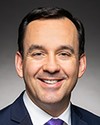In terms of the capacity in the AFI network itself, the 58 AFIs that we do have are governed independently in their own region. They each have their own board of directors. When you look at them, you see that the AFIs themselves have different capacities. The ACCs tend to operate a little differently; a lot of the successes we're seeing are coming out from there. You also have the Community Futures Development Corporations. They need probably a little more capacity development, because of the nature of how they're structured, etc. That's why we're looking at the whole standards and accreditation issue for AFIs.
In terms of the programs to strengthen, it's not only the network but the people who we serve in the network. We are talking about financial literacy. We are talking about working with communities in a much more intense way to really bring that business education to the community at all levels, from kids in school to the people who want to start a business. There's a lot of opportunity there.
I know what you mean about Kitigan Zibi. There's much potential there.
But again, it's really about getting the understanding of how do we begin to animate all of this and the different structures that are required. It's an education process. It has to happen with the chief and council and other players in the community, as well as the private sector that is starting to develop in the community. I think that being clear on the roles that each has is a big part of the educational needs in the community. It's really hard to make that happen when you're able to finance maybe three or four businesses a year. It takes a much broader discussion, from governance to models that are available for communities.
In terms of some recommendations for the committee, it's really that we need to broaden the understanding of what is and is not working in the communities. I think we get a sense of it. We keep hearing about the finance authority in the first nations financial management act as one model, but it's not for everybody. To be honest, I don't know the extent to which that is subscribed and has pulled participants in, or the impact. We're just now starting to see the loans that are made under that model, but there are also alternate models, and we need to understand what they are and we need to assist the communities at the chief and council level to be able to put those into play and test them.
The AFIs come into the picture in working with the entrepreneurs and building that capacity there. There are a lot of different roles going on and that you see are required in the community. A number of players have to be animated, not just business lenders but the whole community.
That goes for both on and off the reserve as well. A lot of the businesses, if you look at them, or a lot of the activity in the community, is very concentrated in the band council because of its authority in the community and as the only legal framework that exists. How do you step out of that and broaden the access and the participation of a much greater segment of the community in order for them to be able to be owners and managers of the capital as well as the structures within their community? I think it has to be separated out a bit.



